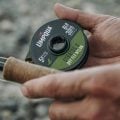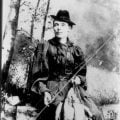How to Tie the Isonychia Smoke Jumper
Producer: tightlinevideo
With hopes of some rain and cooler temperatures coming this fall, thoughts turn to Isonychias. I’ve had success fishing Iso emergers towards dark and this Iso Smoke Jumper has worked really well for the last couple of years.
The fly starts with a Lightning Strike SE1 Scud/Emerger hook in size 12. You can go up to size 10 if you like. Get the hook firmly secured in the jaws of your tying vise.
For thread, I’ve loaded a bobbin with a spool of UTC 70 Denier in black. Get the thread started on the hook shank and, after taking a few wraps rearward, snip off the excess tag. Continue taking thread wraps well down into the hook bend, then back up the shank, until your thread hangs at about the hook point.
Pull down on your bobbin to expose about 4” of tying thread. Although many Isonychia dubbings will work for this pattern, I really like this older UV2 Fine & Dry stuff from Spirit River. Pull an ample clump free from the packet. Use the dubbing to create a 4” long, rather thick noodle on your tying thread. Hold the thread at the bottom of the noodle and bring your bobbin back up to the hook and take wraps to secure the thread behind the eye. You can then snip that thread off close. Get hold of a pair of plunger-style hackle pliers that have a ring attached, as many do. Using the pliers, get hold of the bottom end of the noodle, but take a wrap around the pliers’ hook with your tying thread, to trap both the dubbing and the thread. You can then snip the excess thread off clean.
Grab a dubbing whirl and hook it into the ring of the pliers, then give the whole assembly a clockwise spin, as if you’re looking down on it. This will cord up and compress the dubbing noodle in a big way. Remove the whirl from the hackle plier ring, then start taking wraps with the noodle, so the dubbing begins down near the last few wraps of tying thread. As you wrap the noodle, you should notice that it creates a segmented, lightly tapered body. Stop wrapping about 3 eye-lengths from the back edge of the hook eye and take thread wraps to secure the excess noodle there. The excess can then be trimmed off close. Take a few thread wraps to smooth out the transition from the body down to the shank. Although not essential, I do like to rotate the fly in the jaws of my tying vise just a bit for the next few steps. This dubbing method may seem a little complex but, in the end, I think the look of segmentation is well worth it.
Two light dun, long CDC feathers are used for the wing and wing case of the fly. Align the tips of the two feathers and get hold of them with the tips pointing to the rear of the fly. Measure to form an emergent wing a full hook in length, then transfer that measurement rearward to the front edge of the dubbed body. Use a pinch wrap, followed by a few more tight wraps, to firmly anchor the somewhat slippery CDC to the top of the hook shank. Then, lift the butt ends up and snip them off at a shallow angle. Cover and smooth the butt ends with wraps of tying thread, ending with your thread about halfway between the base of the wing and the back edge of the eye.
Now, remove the cap from some sticky dubbing wax and set the wax aside within easy reach. While you’re at it, get hold of a decent clump of mahogany brown beaver dubbing and set that aside within easy reach as well. Pull down on your bobbin and double the thread over once again, this time, to form a dubbing loop. End with your thread at the back edge of the hook eye. Coat both legs of the loop with a light skim of dubbing wax, then pick up the clump of dubbing and pull small slips from it. Insert the slips between the legs of the loop, then hook your dubbing whirl into the bottom of the loop. At this point you can make slight adjustments to the dubbing, if needed. Once again, give the whirl a good clockwise spin. This time the dubbing will cord up into a fuzzy little noodle. To make wrapping easier, secure the bottom of the loop to plunger-style hackle pliers in the same way as before. Here, you want to get hold of just the thread rather than the thread and the noodle. Then snip the whirl free.
Begin making touching wraps with the noodle to build up an ample thorax on the fly. Secure the noodle at the back edge of the hook eye and snip the excess off close. You can then take a few thread wraps to clean the area up. Fold the CDC wing over the thorax to form a wing case. Push it back just a little so it’s somewhat loose over the thorax, then take a wrap or two to secure it. Pull the front part of the wing up and take a couple of thread wraps behind the eye to prop it up, then take a couple more right in front of the wing case for security. In preparation for whip finishing, pull the wing back and relocate your thread to right behind the eye.
Get hold of your whip finish tool and use it to do a 4 or 5 turn whip finish, seat the knot well and snip or cut your tying thread free. The fly should now look something like this. As a final step, get hold of your favorite dubbing brush and use it to rough up the thorax dubbing. This roughed-up thorax holds floatant well and, along with the floating properties of the CDC wing and wing case, helps the front of the fly to float in the surface film, while the segmented rear portion hangs realistically beneath it.
How to Tie the Infamous Pink Worm
How to Tie the Isonychia Soft Hackle











